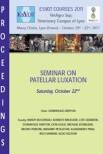OBJECTIVES: To describe the use of hemiepiphysiodesis for the treatment of proximal tibial deformities in immature dogs and evaluate the effect on the mechanical medial proximal tibial angle (mMPTA).
METHODS: Skeletally immature dogs with proximal tibial deformities from three institutions treated with hemiepiphysiodesis between March 2006 and January 2015 were included. All dogs were required to have an mMPTA outside the previously published reference range (93.3 ± 1.78°) preoperatively. Dogs were required to have radiographs or computed tomography performed preoperatively and at least eight weeks postoperatively.
RESULTS: A total of 19 dogs (n = 31 limbs) fulfilled the inclusion criteria. The mean mMPTA was 102.5° ± 5.3° preoperatively and 92.4° ± 7.2° at the final re-evaluation. The mean difference in mMPTA was -10 ± 5.1° (range, -1 to -19°; p <0.001). Overcorrection was observed in 16 limbs and mMPTA remained above the reference range in nine limbs. Rebound growth was observed in eight limbs where implant removal was performed.
CLINICAL SIGNIFICANCE: Hemiepiphysiodesis for the treatment of proximal tibial valgus is a technique that allows for reduction in mMPTA and should be considered as an early treatment for immature animals that are presented with proximal tibial deformities. Serial radiographs to monitor for overcorrection should be performed. Implant removal should be considered if overcorrection occurs, taking into consideration that rebound growth may be observed.









